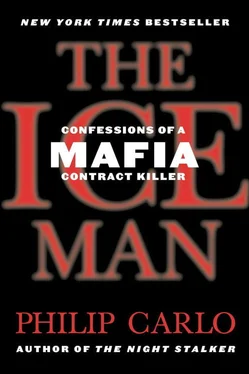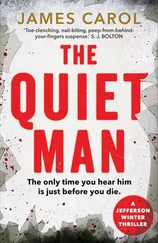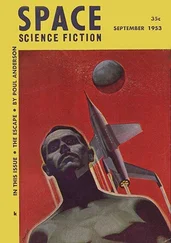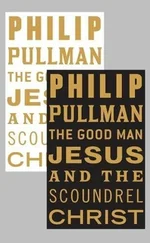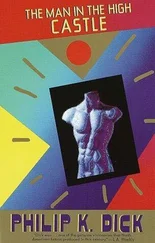Percy House was afraid of Richard. He knew how dangerous Richard was, that he’d kill as readily as he’d scratch an itch. But he hated being in jail; he wanted to be free, and he knew the only way he’d ever get out of jail was to talk, to tell what he knew, to cut a deal. Yet the prospect of crossing Richard was a daunting, unsettling thing. He took a long, deep breath, finally said: “Look… I can give you some names. I’m not sayin’ Big Rich killed ’em… but some people say he did kill ’em.” And House went on to tell Kane about the murders of three people: Louis Masgay, George Malliband, and Paul Hoffman. He knew about these killings because his brother-in-law, Phil Solimene, had told him, and thus the investigation into Richard Kuklinski suddenly took on new life.
Armed with this information, Kane began to investigate these three killings. Kane did not like or trust Percy House, but he sensed he was telling the truth, though he needed concrete proof that could be used in a court of law. It didn’t take Kane long to find out that in both the Hoffman and Masgay killings, Richard Kuklinski had briefly been questioned, and had denied knowing either man. It had ended right there. Kane quickly realized that the crimes’ happening in different police jurisdictions was hampering any kind of solid investigation from moving forward. Kane mentioned what he had to state prosecutor Ed Denning.
“Wait a second. Kuklinski… I know that name,” Denning said. “But not connected to these murders. There was a grisly murder a while back, a guy named George Malliband. That was one of the names Percy House mentioned. He was found sticking out of a barrel in Jersey City. He’d been shot five times, dismembered, his leg cut off so it could fit in the barrel. A big man. He told his brother on the day he was murdered that he was going to meet this guy… this Richard Kuklinski.”
“You’re kidding,” Kane said, stunned.
Denning continued: “But no one ever saw Kuklinski with Malliband, and the investigation never went anywhere.”
It will now, Kane thought, and silently vowed that he would not rest no matter what until he got to the bottom of this. All things in his life would become secondary—his children, his wife, any other cases he’d been working on.
Back at his desk, Pat Kane wrote a meticulous report outlining everything he had learned. The file on Richard Kuklinski was growing. For the first time someone in law enforcement was looking at the pieces, carefully scrutinizing them, making sense of where they fit.
However, when Kane told his superiors and colleagues what he had, what he thought, they flat out didn’t believe him; in fact they mocked him, snickered behind his back, made jokes at Kane’s expense. They sarcastically dubbed Kane’s file on Kuklinski “the Manhattan Project,” after the A-bomb project, because the file had become so big, now containing crime-scene and morgue photos, maps, and police reports from numerous jurisdictions.
Kane was right on target. Yet, they treated him like a fool.
“Pat,” one of his bosses condescendingly said, “you’re saying you’ve got a guy here that poisons, shoots, and strangles victims, cuts legs off too. There’s no consistency here. Come on, open your eyes, Pat.”
Still, Pat Kane believed with all his heart and soul that Richard Kuklinski was a diabolical serial killer hiding in plain sight—a master criminal—and he was intent upon proving it. But how? Where to start?
Kane knew too that if he was right about Kuklinski, he and his own family might very well be in danger. He was sure Percy House was capable of telling Kuklinski about him. He knew Percy House might try to use Kuklinski to take him, Kane, out of the picture. With Kane gone, House would have a better shot at getting out of trouble. It was Pat Kane who had built the case against House, who had dotted all the i’s and crossed the t’s.
Kane’s boss, John Leck, was worried about the young Kane. He believed he was suffering from some kind of delusional fantasy. Resources were scarce. Leck could not afford to tie up one of his investigators in murders that took place in other jurisdictions, let alone whose victims were thieves and degenerate gamblers, the very dregs of society. Who cared? Leck wrote up Kane’s ineptness to his youth, and he warned Kane to focus on other cases, to get over “this obsession you have here.”
“Yes sir,” Kane said, clenching his teeth.
Late that February, Roy DeMeo contacted Richard, and a meeting was set up for the following day. Richard left for Brooklyn a little after noon. He had a short-barreled .38 stuck in his pants, a pistol and knife strapped to his calf.
Richard met Roy as planned at the Gemini. Roy didn’t look good at all. Richard hadn’t seen him in a month or so, but Roy looked as if he had aged ten years. He was gaunt, his hair was uncombed, and there were eggplant-colored circles under his eyes. They got into Roy’s Cadillac, and as Roy drove, he told Richard about his concerns, about the cases against him, about how federal prosecutor Walter Mack was going to charge him with the murder of both Espositos.
Roy, Richard thought, seemed like a beaten man, a man at his wits’ end. They parked in a desolate spot in Sheepshead Bay and Roy went on and on about his troubles, how everything had turned against him. Richard had always viewed Roy as a tough, stand-up guy. But the man sitting next to him now was a mere shell of the man he knew.
Richard was concerned… indeed, very concerned: after all, DeMeo knew the intimate details of numerous murders Richard had committed. Sitting there listening to DeMeo whine, Richard remembered how DeMeo had pistol-whipped him, pointed the cocked Uzi at him, embarrassed him in front of everybody.
Rage soon began replacing any empathy Richard might have felt for DeMeo, and Richard made up his mind there and then to finally get even, and before DeMeo knew it Richard pulled out his .38 and let loose, shooting DeMeo five times, twice in the head, killing him. Richard then struck DeMeo numerous times with the butt of the .38, just as Roy had struck him, cursing him as he did so. Richard opened the trunk of DeMeo’s car, threw him in it. There was, Richard noticed, a lamp on the rear seat of the car. Richard knew it belonged to Roy’s wife, Gladys, and he removed the lamp from the rear seat and gingerly put it on top of Roy’s body. He didn’t want, he explained, anyone to steal it. He closed the trunk and left DeMeo there like that, the lamp resting on his body.
As Richard began to walk in the direction of Flatbush, he had mixed feelings about what he’d just done. On the one hand, he was elated: he finally had his long-awaited revenge. On the other hand, he was sad; a part of him had taken a liking to Roy. They were, he knew, in many ways alike. Be that as it may, Richard walked on, glad DeMeo was dead, for dead men tell no tales.
It was a large, dark brown, mean-eyed turkey buzzard, and it was intently picking at something wrapped up in black plastic, violently tearing away pieces of flesh.
By pure happenstance a man on a dirt bike came riding down the lonely stretch of road near the West Milford reservoir, spotted the bird, slowed to see what it was eating. Through a hole in the bag, no doubt made by the sharp beak of the buzzard, the cyclist discerned a human arm, definitely a skeletonized human arm sticking out of the bag, seeming to wave for attention, for help. Disturbed, the buzzard took flight. Not sure if the arm was real or not, the cyclist moved closer and now saw a human head sticking out of the bag. It had a Fu Manchu mustache and missing front teeth. The bicyclist immediately went to summon the police, pedaling so hard he nearly fell twice as he went.
The police removed the bag with the remains to the medical examiner’s office. As the ME peeled away the plastic, which had a tendency to preserve a body, a huge cloud of flies left the corpse, and then came hundreds of fast-moving carrion beetles out of every orifice. The ME found a billfold in the dead man’s pocket filled with photographs of children. She laid these photos out in the hall of the medical examiner’s office, hoping maybe someone recognized the children.
Читать дальше
